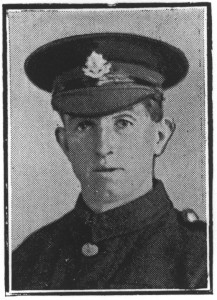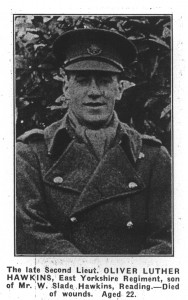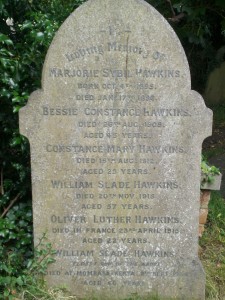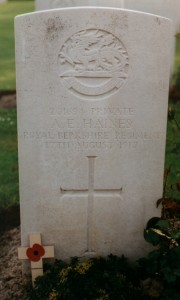Albert Edward Haines
Private 201694
1st/4th Battalion Royal Berkshire Regiment
Division 79
Extension
Albert Edward Haines was the youngest son of Walter and Annie Haines. He is remembered on the kerbs of his parents grave although the lead lettering is now badly damaged and the actual wording very indistinct. Albert died 17 August 1917.
Albert Haines is actually buried in New Irish Farm Cemetery Location X.E.I. This cemetery was begun in August 1917 and used until November 1917, and again from April to May 1918. By the time of the Armistice it contained 73 graves in Plot 1. After the Armistice it was used as a concentration cemetery taking graves from smaller cemeteries and also bodies from the battlefields. There are now 4,500 casualties commemorated in the cemetery. The body of Albert Haines was initially buried in one of these smaller cemeteries at the time of his death and moved after the Armistice.
Albert Haines would have played a part in the action (The Battle of Langemarck), outlined below which was part of the Third Battle of Ypres. On the 16th August the British, on the northern flank of the battlefield, took the village of Langemarck, although the they were subjected to strong counter attacks. On the southern flank, the most important, there was failure. (Martin Matrix Evans) It is not known whether Albert Haines was killed in action or if he died of wounds.*
For the 1st/4th’s their time in Flanders was one of their worst. It seemed to the battalion that they were given impossible objectives and reinforced with inadequate reserves. In the attacks, at dawn on the 16th August, the 48th Division made little progress and they were reduced to hanging about under heavy shell fire moving into gaps against threatened counter attacks. The battles against pill boxes, gun pits and fortified farms were slow. Each objective was taken methodically by bombers rushing, as best they could through a ground of liquid mud in full kit, and throwing bombs through loop holes this was followed by concentrated machine gun fire. “A” company was hit by the opening barrage which killed their captain and wounded their other officer but they managed through the day to repel some small attempts of counter attack. “B” company also experienced difficulty getting through the barrage and spent most of the day in support of “A” company and without actually coming into contact with the enemy lost forty men. “C” company took part in fighting around the Langemarck road and lost all their officers and fifty men. “D” company did not move until the barrage had eased and spent most of the day in support of the Buckinghamshire battalion, they lost thirty men. By the end of the day one third of the 1st/4th Battalion’s strength had been lost. (From “The School,The Master, The Boys and The V.C” thestory of the Alfred Sutton School War Memorials )



